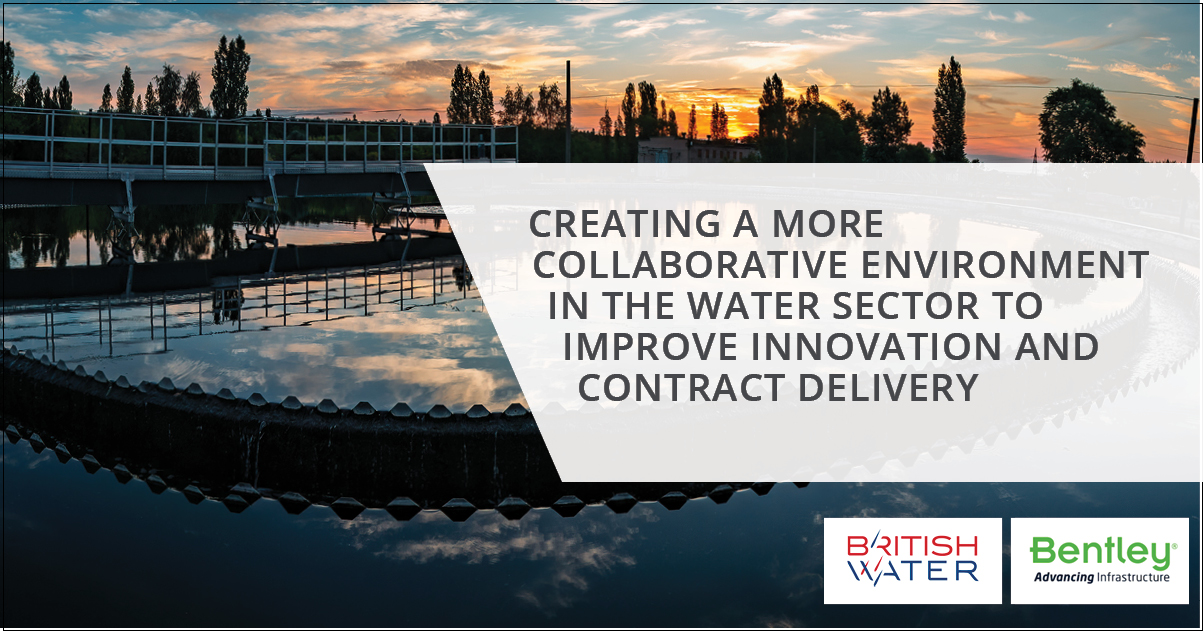Creating a More Collaborative Environment in the Water Sector to Improve Innovation and Contract Del
15 June 2022
Posted by: Neilas Svilpa

Creating a More Collaborative Environment in the Water Sector to Improve Innovation and Contract Delivery
By collaborating rather than competing, the water sector can continue to improve innovation and deliver more efficient contracts within the supply chain
Mark Coates, International Director of Public Policy and Advocacy, Bentley Systems
There are 12 water and sewage companies across the regions and nations of the United Kingdom. The water sector, in comparison to others within energy, should inspire greater collaboration because water providers know their customer base and are not directly competing with their rivals for the right to supply to domestic customers.
The sector is heavily regulated and, despite reforms within the last decade, is still a regional monopoly.
We know that competition drives innovation. In the 1990s, Apple knew that they needed to change their approach to counter the dominance of Microsoft, becoming the world’s first trillion-dollar company as a result.
In our own water industry, how do we innovate and deliver a more efficient service to customers without the free market competition of other similar industries?
In the years since privatisation, the sector has been effective at collaborating to meet regional demand. For example, Yorkshire Water collaborated with Anglian to supply water from the water-rich Humber down to drier East Anglia, where drought conditions are more common.
However, the sector has not always been strong at collaborating within its own supply chain. Innovation has fallen short here, and suppliers and contractors alike have found themselves sometimes tied to onerous contracts that do not serve as intended.
For decades, these client and contractor relationships were adversarial rather than collaborative. They became purely focused on the bottom line, with both sides only working to carve out the best deal for themselves rather than mutual interests and delivering the best results for customers who ultimately benefit.
When clients dictate the terms that contractors must operate, onerous contracts are often created where nobody ultimately wins. These contracts can become even more adversarial as a result, as both sides look to minimise risks and prepare to defend themselves in case things go wrong, often resulting in dispute resolution and litigation.
These contracts run contrary to the wider nature of the industry, so it is counter-intuitive that we work this way with contractors. After all, we work closely with our regional neighbours in water supply. Why should it be so different with our delivery partners?
Anglian Water have created the @one Alliance to improve collaboration and innovation within the water sector, seeking to push the boundaries on the way it collaborates with others in infrastructure and adopting a relationship-based approach to procurement and delivery.
It works to pre-agreed prices and conduct procurement in a manner that is honest and accountable, encouraging people within Anglian to self-nominate to take on a project, rather than shoehorning talent into projects that poorly suits their skills.
The alliance also aims to collaborate with suppliers as much as possible, listening closely to their expertise instead of imposing terms upon them and using up valuable time spent going back-and-forth on design.
At a national level, the sector has a proven track record of wider collaboration with various stakeholders within the water industry’s supply chain, from major infrastructure providers to high-tech suppliers fuelling the industry’s data and digital transformation.
Industry bodies like British Water and events such as the BIM Conference bring the sector closer together, creating a collaborative environment where industry leaders gather and share ideas.
The water sector is also proud to be the first of its kind to unite on an industrywide pledge to reach net-zero emissions by 2030. Water companies and their suppliers have set ambitious goals to reduce their emissions and create a more sustainable environment, potentially saving 10 million tonnes of greenhouse gases.
It is testament to the industry’s track record for collaboration that its decarbonisation plans can be met two decades ahead of the government’s legally binding net-zero target of 2050.
This culture is not developed overnight, however.
Stakeholder relationships have been carefully built within the sector and its wider supply chain for decades. It is also building transparent relationships with its customer base at a time of spiralling energy costs.
With the water sector facing new challenges in AMP 7 and beyond because of a growing population, increased urban development, and climate change, it is important that we continue to create a collaborative environment to improve our innovation and deliver more efficient contracts within our supply chain.
|